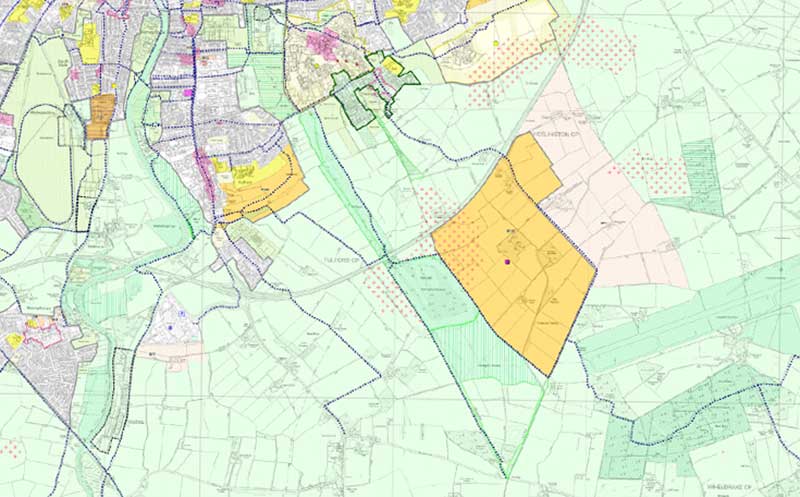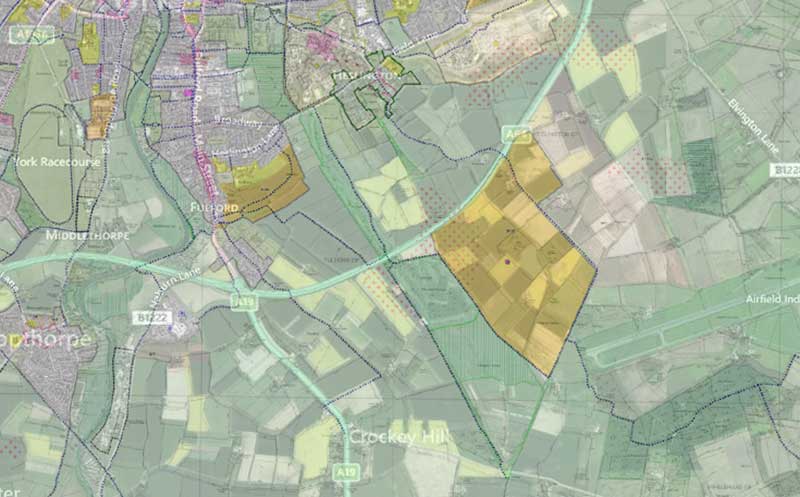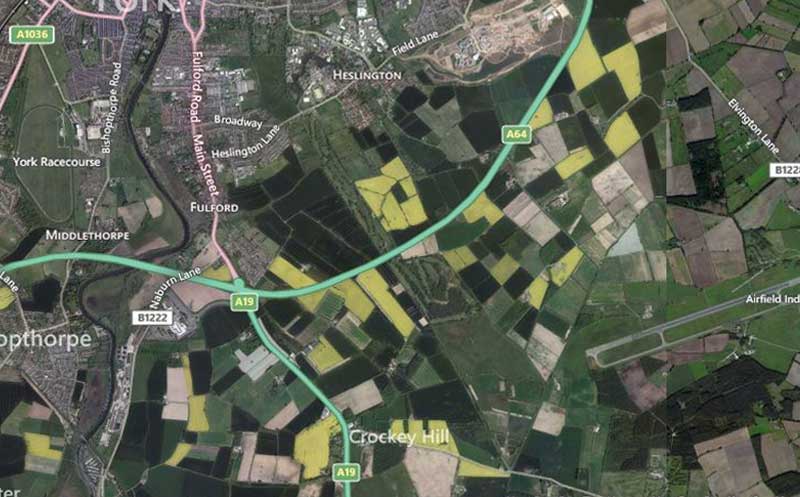![]() Could the developers of a massive York housing development make £350 million for doing nothing? Geoff Beacon thinks so
Could the developers of a massive York housing development make £350 million for doing nothing? Geoff Beacon thinks so
*Please see below for City of York Council’s response to this article*
My previous blog suggested that land owners in York will be able to ask about £50,000 extra for a housing plot just because it has planning permission. This extra value is often called “planning gain”. This is because in York only a few organisations are being given the right to build houses under the recent proposed 20 year plan for York.
In the comments section John Dodsworth pointed out that he had a three bedroomed house built for just over £50,000. I know he already owned the land and got a good local builder to build it.
Because he was able to get planning permission, he did not have to pay the £50,000 planning gain to anyone else. This shows the planning gain and the cost of building are roughly equal, giving the same balance as Timothy Worstall’s comment below.
Although I have taken an interest in this issue and discussed the value of planning permission with planners at City of York Council, I do not know in detail the pattern of land ownership in York. But I was disappointed that they did not seem to know either.
I did encourage York’s planners to have a Local Plan which did not create monopolistic allocation of planning permission. My impression from the shape and size of the areas planned for new housing is that a very small number of people will control the building process. That’s monopolistic.
From an article in The Press, I do know that the Halifax Estates may be given planning permission for a large proportion of the 22,000 houses in the draft plan – the Whinthorpe development.
One member of the university valued this at £350 million, grumbling “for doing nothing”.
If the plan is finalised, I believe the Halifax Estates could sell on their designated land with a planning gain premium of £50,000 per house.
Because it is a memorable phrase, I will call this planning gain premium, when applied to housing, the “Halifax tax”. I do not mean this as being specific to Halifax Estates: I mean it to refer to all housing planning gain.
I have some regret in using this term because the reports in The Press of the village planned by Halifax Estates makes it sound very worthy. But reference to this specific example will set the meaning in our minds, especially mine.
I also think it is good to base the general argument on a best case example.
What is the national value of the Halifax tax?
Stamp duty land tax is a tax on land transactions that was introduced by the Finance Act 2003. It is often criticised, for example in the Daily Mail, ‘Britons pay highest property taxes in the world: Charges like stamp duty mean we fork out £60 BILLION a year’.
Actually about £5 billion of this £60 billion is stamp duty land tax. The Mirrlees Review from the respected Institute for Fiscal Studies says
In my last blog I quoted commentator Tim Worstall, who said the solution is to issue lots more planning permission, and estimated the cost of building a typical three-bed house as £120,000.
Can you find a three-bedroom house south of Birmingham for under £250,000? Perhaps, in particularly blighted or Welsh areas, but that’s most certainly not the general experience.
So half the value of such a house is the chitty that lets you build on that particular piece of land.
Timothy Worstall is estimating the Halifax tax to be £125,000 per new house – significantly more than my £50,000 for a new house in York.
Applying the lower figure to annual housing starts, which totalled 110,530 in the 12 months to June 2013, gives the annual national value of the Halifax tax to be over £5 billion – which is comparable to the revenue which the Treasury gets in stamp duty land tax.
If Timothy’s values were a national average the annual value of the Halifax Tax would be twice the income from stamp duty land tax.
One key difference is that the Halifax Tax goes to land owners and the stamp duty land tax is paid to the Treasury but no-one seems to notice. It even seems to have bypassed the clever people at the Institute for Fiscal Studies.
Who benefits from the Halifax tax?
The obvious answer is land owners and land option owners, but these are not the only beneficiaries. All us house owners should be grateful for the Halifax tax because it keeps the price of houses high. Cheaper new houses undermines our investments.
House prices keep the economy going. Double the value of our houses and we have a few years of national income to spend. In times of booming housing markets, the wealth of house owners rises much faster than most of them can earn.
Prices can fall, of course. That’s really when the trouble starts.
It would be dangerous, given the way our economy currently works, to depress the value of houses and the Halifax tax too much: It would cause a fall in property prices which would damage house owners and also pension funds that have invested in property.
The property-less poor and the property-less young do not benefit. More of that next time.
Halifax tax and the national economy
Money Week are currently peddling a video The End of Britain warning that Britain’s debts (four times the national income) will cause financial chaos and a house price crash. But we have bought
- oil from the Arabs,
- gas from the Russians and
- goods from the Chinese.
But the good news (for the economy) is that they are now buying London and soon they will be buying York. The Chinese will be especially good customers because the university is importing their sons and daughters as students.
They may be the advance guard of a new wave of Chinese immigrants. Different from past waves of Chinese immigration, these will be wealthy ones, not so subject to our immigration laws.
As a nation we should welcome this influx. Our economy benefits. As house owners we benefit.
Pity about the poor but that serves them right for being poor.
York council’s response
York council officers disagree with Geoff’s interpretation of some of these issues. Here is their response in full.
The interpretation of ‘planning gain’ is incomplete – whilst Planning Gain does refer to the value of land which results from planning permission being granted for that land, this increase in land value and this value doe mainly accrue to the landowner, a levy or tax is often applied by the Local Authority to divert from of the planning gain to the public sector. Such arrangements are negotiated between the developer and the Council and are agreed before work on a development starts. They are set out in a legally binding contract. In other words, the landowner doesn’t just make endless profits.
“Only a few organisations are being given the right to build houses under the recent proposed 20 year plan for York” – it is not the role of the Local Plan to give people the right to build houses, its purpose is to plan properly to accommodate York’s future housing growth through directing the location of new housing to locations that conserve and enhance the city’s historic and natural environment, ensuring accessibility to sustainable modes of transport and a range of services, preventing unacceptable levels of congestion, pollution and/or air quality and ensuring flood risk is appropriately managed. The identification of development sites has been underpinned by the principle of ensuring deliverability and viability. It should be noted that the plan is still in draft and no final decision has been made on sites. No sites have at this time been allocated and those sites included in the preferred options document are only draft allocations.
“I do not know in detail the pattern of land ownership in York. But I was disappointed that they did not seem to know either” – through the ‘call for sites’ process the council has evidence of available housing sites with a willing landowner/developer.
The National Planning Policy Framework requires Local Plans to be aspirational but realistic, to this end housing sites should have a willing landowner/developer to ensure that the plan is deliverable.
City of York Council has undertaken work to establish an evidence base of available housing sites with a willing landowner/developer within the City of York Local Authority area. Using this information, alongside a spatial strategy which seeks to support the delivery of the city’s economic and social ambitions whilst conserving and enhancing its unique historic and natural environmental assets, a series of draft allocations have been included in a Preferred Options Local Plan.
Area wide viability assessment work has been undertaken by consultants Peter Brett Associates to assess the viability of development across each of the key property market sectors to demonstrate at a basis level whether the amount and distribution of development in the Preferred Options Local Plan can be viably delivered. As we work towards a submission draft plan Local Plan more detailed bespoke site viability work will be undertaken for sites over 5ha as well as additional work on smaller sites. This will explore land economics in an open and transparent manner including level of developer profits, building costs and level of planning gain for he Council to support infrastructure improvements.
We look forward to engaging with Mr Beacon as we progress work on preparing a Local Plan for York.
To read Geoff Beacon’s comments on some of these points, click here to download his letter with more details (Word document).


